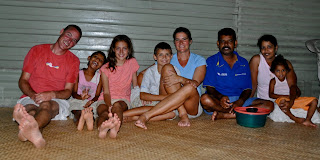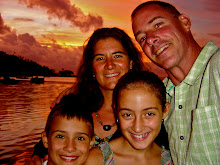I am writing while seated on the Interislander ferry, which is to take us from Picton on the South Island to Wellington on the North Island of New Zealand. The trip should take four hours across Cook Strait and land us in the heart of the capital. We’ll stay there for ten days catching up on things, exploring the sights, etc. and then we’ll gradually head up north for our departure from Auckland on July 1.
We have been on the South Island or “Mainland” as many residents call it, since early April. In that time, we have traveled much, both by rental car and by campervan. We have witnessed many incredible vistas, tramped (gone on hikes), spotted a number of new (t0 us) bird species and (Ben has) driven literally thousands of kilometers around the island. We have continued with homeschool and finally started to shape our post-trip life and our return back to Bainbridge in early August. We’ve also watched as New Zealand’s weather has turned from a gorgeous Indian Summer to "Seattle-in-November,” a big shock since we haven’t lived in anything other than summer climes for over year.
Winter Blows In on the SE Coast, South Island, NZ
All this moving around has prompted quite a bit of discussion of late among the traveling Drury’s. Which is the better way to go? Is it "slow travel," where you stay in one place for a long time? Or is tourist travel travel better, where you cover lots of ground and do lots of exploring in an effort to get a taste of a larger country or region. Upon reflection and based on our experiences this year, it seems to me that this answer is, “It depends.”
While in Fiji, we rarely strayed more than 20 km away from our home at SigaSiga. The pace of life was much slower -- we literally planned our days around the tides. With no car, we hoofed, bussed or cabbed it everywhere. With nothing to buy, there was no reason to go into town unless we really needed food. We explored our surroundings at a much slower and deliberate pace, returning to spots numerous times, establishing weekly rituals, like joining the Rotary folks for dinner each Tuesday. In the course of all this, we made many more lasting friendships, learned a lot about the peoples we were living around and, in our own tiny way, were actually a part of Savusavu goings on for a time.
Home in Fiji
The cost of living this “slow travel” existence was that we only managed to really explore one small part of one of Fiji’s 300 islands. We became experts on the SigaSiga reef at the cost of missing thousands of kms of other reefs. We got to know our First Fijian and Indo-Fijian neighbors to a certain point but left, we felt, as we were just on the cusp of taking our friendships to a new level, with all the good and bad that that entailed.
Our wonderful neighbors at Siga Siga
We left Fiji having only scratched the surface. If Savusavu were just a short hop away from the States, or if there weren’t so many other island chains to explore in the South Pacific, this wouldn’t be all that troubling. Now that it is behind us though, I think we are all missing that sense of belonging we felt as part of the Savusavu scene. It remains the sentimental favorite part of our trip.
Our travel experience in Australia and Tasmania, Thailand, Singapore and now here in New Zealand by contrast have been broad stroke. The longest time we have stopped anywhere was at most two weeks -- okay, we did stay for a month and then some in Bangkok. We’ve gained a good broad view of what each country was like. We’ve learned more or less how to get around, where the great tourist and cultural spots are and how to quickly get settled in and comfortable in budget accommodations for four.
We have experienced first hand some of the downsides of all this “tourist travel” as well though. It can be a very difficult and sometimes a lonely existence traveling from place to place, living out of a few suitcases and having to get one’s bearings over and over again. City and place names have a tendency to melt into each other. And it has been really challenging to meet locals, requiring a level of “family togetherness” that is sometimes hard to sustain. We had none of these problems in Fiji – well, except for the family togetherness struggles at times. Life had developed a kind of normalcy there that we've really missed and haven't been able to duplicate since.
For the above reasons, one might think that slow travel has the edge over fast. But consider the variety of places we’ve visited this year. Savusavu was tiny and, because of the bad roads and our lack of transportation, we had to travel slow. The population was likewise small and incredibly welcoming. We couldn't help but feel at home, almost from the get go. To some extent, we chose Savusavu as our first destination because we knew that we wanted to live on "Fiji Time."
Thailand
"Fiji Time" does not exist everywhere though. We all agree that we could not live in Thailand for an extended period. How long would it take anyway to feel like you are a part of a community like Bangkok, with ten million people speaking a different language, with a vastly different set of cultural rules and traditions and undergoing a major political upheaval? No, we didn’t stay as long but by moving around a lot, we did manage to learn a lot about Thailand. We even got a little snippet of understanding of the significant political challenges that are facing the country as the Red Shirts and government battle it out over who is really in charge.
Freedom Camping is the way to go in NZ
Then there are places like New Zealand, which is so large and rich in terms of natural wonders that it would be a shame to spend a huge chunk of time in any one region. We all agree that we would be bored silly had we stayed in Christchurch for six or eight weeks as we had originally intended. You just need to get out and about to experience the beauty of the place. Having spent the last week motel-hopping around the north coast of the South Island (never again!), we are all in agreement that the way to do it is by campervan. The same goes for Tasmania, where we spent ten days doing a clockwise loop of the island by campervan. Campervan allows for travel yet you only have to unpack once and have a kitchen with you at all times.
Campa Sleepa
Yes, the fast travel in Tassie, Thailand and New Zealand have been very stressful at times, but I can’t imagine another way we could’ve planned our itinerary to best accomplish our widely varied goals for each visit in the context of such very different places.
Our Talented Photographer
There are ways to combat the isolation and lack of in depth knowledge of a place that comes with traveling fast. We have sought out and read books by local authors detailing the history of the places we’ve visited. We’ve walked a lot, and we’ve relied on public transportation instead of a car to get us around. We’ve perused the internet, watched the TV news and read the papers. We’ve asked lots of questions of locals or expats when we have run across them. (Cab drivers have been a particularly good resource.) Perhaps most importantly, we have tried to keep open eyes, ears and minds into the cultures we are visiting, thereby noticing things that a less-traveled eye might miss. That is perhaps the biggest and most valuable souvenir of our year studying abroad.
So, it seems to me that the places we've visited this year, for us at least, called for different travel strategies. We couldn't do it all and we couldn't "do" each country the same way. With lots of help, lots of luck and a strong willingness to be flexible, we have managed to put together a really great year. And it isn't over yet!














